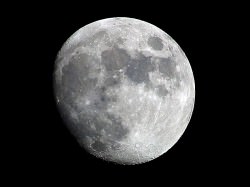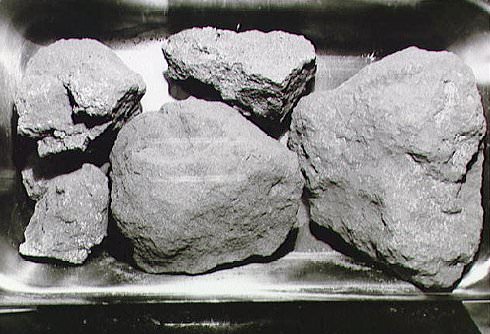Are we perhaps one step closer to being able to live on the Moon? A new device developed by scientists in Cambridge, UK, can extract oxygen from Moon rock. This technology would be extremely important for creating a lunar bases for long term habitation, or using the Moon as a jump-off point to explore the deeper reaches of space.
The new device, a reactor developed by Derek Fray and his colleagues, was created from a modified electrochemical process the team invented in 2000 to get metals and alloys from metal oxides. The process uses the oxides — also found in Moon rocks — as a cathode, together with an anode made of carbon. To get the current flowing through the system, the electrodes sit in an electrolyte solution of molten calcium chloride (CaCl2), a common salt with a melting point of almost 800 °C.
The current strips the metal oxide pellets of oxygen atoms, which are ionized and dissolve in the molten salt. The negatively charged oxygen ions move through the molten salt to the anode where they give up their extra electrons and react with the carbon to produce carbon dioxide — a process that erodes the anode. Meanwhile, pure metal is formed over at the cathode.

To make the system produce oxygen and not carbon dioxide, Fray had to make an unreactive anode. “Without those anodes, it doesn’t work,” said Fray. He discovered that calcium titanate, which is a poor electrical conductor on its own, became a much better conductor when he added some calcium ruthenate to it. This mixture produced an anode that barely erodes at all — after running the reactor for 150 hours, Fray calculated that the anode would wear away by roughly three centimeters a year.
To heat the reactor on the Moon would need just a small amount of power, Fray said, and the reactor itself can be thermally insulated to lock heat in. The three reactors would need about 4.5 kilowatts of power, which could be supplied by solar panels or even a small nuclear reactor placed on the Moon.
In their tests, Fray and his team used a simulated lunar rock called JSC-1, developed by NASA. Fray anticipates that three reactors, each a meter high, would be enough to generate a ton of oxygen per year on the Moon. Three tons of rock are needed to produce a ton of oxygen, and in tests the team saw almost 100% recovery of oxygen, he says. Fray presented the results last week at the Congress of the International Union of Pure and Applied Chemistry in Glasgow, UK.
Source: Nature


One ton of oxygen a year? Air is about 20% oxygen, so one ton of oxygen will be good for five tons of air. Air has a density of 1.2kg per cubic meter, so five tons of air will fill about 4,170 cubic meters.
The average human inhalation is 500 cubic centimeters, or 0.0005 cubic meters. So the oxygen will last about eight million breaths. Eight million breaths at about one every two seconds is only about six months, so these three meter-tall contraptions will not be able to meet the oxygen requirements of even a single person. You’d need a great many of them, or supplement them with plants that turn the CO2 the astronauts breathe out back into O2.
Then there’s the corroding anodes. They’re, apparently, made of calcium, titanium and ruthenium. The calcium and titanium are probably going to be easy to get but ruthenium is very rare on Earth and probably even rarer on the Moon.
Forget oxygen, are there any recoverable amounts of dilithium crystals? We need to know 🙂
You get dilithium by replacing the ruth with the dilith. Please excuthe my thpeach impediment
I had to google that, never watched Star Trek… but I didn’t immediately get the joke: according to the first entry (Wikip), dilithium actually exists!
To the stars and beyond!!!
The idea behind the mining would be to cut down on very high transportation costs in favor of learning to “live by the land”.
Ruthenium is used in a lot of technologies, and adding minute amounts to titanium for corrosion resistance/catalytic electrodes are among the common applications.
“Roughly 12 tonnes of Ru is mined each year with world reserves estimated to be 5000 tonnes.” [Wikipedia.] So that will be some centuries before it’s too rare to use.
“Eight million breaths at about one every two seconds is only about six months,”
I agree with your calculations but not your interpretation of them. Upon reading your calculation I thought that six person-months of air was quite impressive for new, experimental, technology with room for improvement!
I’m not dismissing the new technology- on the contrary, I think it’s a terrific innovation. I just wanted to point out that, on its own, it’s not going to be enough to support people. It would have to be used in conjunction with other ways of producing oxygen.
The way I see it, a new base on the moon would need to start off with enough oxygen for the inhabitants. Also a lot of plants, or some other means of turning CO2 back into something breathable. The new reactors would be useful to replace oxygen lost in the recycling processes, which would inevitably be less than 100% efficient. And if they wanted to bring new people to the base, the reactors could make oxygen for them before they arrive but after the base is established.
Also, if there is a similar reaction that liberates hydrogen then the base would be steadily increasing its supplies of water- another essential for human life. As for the ruthenium, I think it would be much cheaper to mine and send a few grams of it to the moon than to send a ton of oxygen.
Try again. The average person takes not 30 breaths per minute, but 13. Let’s round up and say 15. That’s not one breath every two seconds, but every four. Since you say that your calculations lead to six months, using this value would lead to one year. Therefore, these reactors would support a single person for one year, even without any oxygen reclamation. As you say, in itself this still isn’t enough to support a colony efficiently, so an artificial biosphere would have to be created to sustain life for long periods. Still, any system has leaks, and this might be a viable way to replenish lost oxygen in the event of an emergency (like they had in biosphere 2).